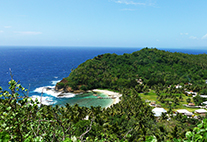World Map with Island Data
15 July 2015, by Franziska Neigenfind

Photo: Inseldatenbank
Now anyone interested in exploring the diverse range of small islands visually can use an interactive online world map.
Now anyone interested in exploring the diverse range of small islands visually can use an interactive online world map. For the first time, the Integrated Climate Data Center (ICDC) at the Cluster of Excellence CliSAP has integrated data from the business and social sciences.
The map is a visualization of the Integrated Island Database (IIDAB), which was created by Prof. Beate Ratter’s working group. As a geographer, the CliSAP researcher has been investigating small islands for several years now. Her working group has compiled a wealth of information from the natural and social sciences on more than 80 small islands and island countries. The resultant database is freely accessible and offers 21 parameters for filtering and sorting. Thanks to a joint effort with the ICDC, there’s been an important visual update: the search results are now geographically linked, offering revealing spatial patterns.
Geographic coordinates for data from the social sciences
To make this happen the ICDC, the center for earth monitoring data at Universität Hamburg’s CEN, utilized what is known as a web geo-information system (Web-GIS). Instead of seeing standard data like the average temperature of the ocean displayed on a grid, users can now view information on the population or the specific threats that natural catastrophes pose for a given island (the climate risk index). Using red dots like in the image below, the map can display immediate results for complex questions like: Which large and densely populated islands are most vulnerable to natural catastrophes?

Results for the query: Which islands have a population of more than 50,000, an area of more than 1,000 square kilometers and a climate risk index greater than 100?
Small islands are hardest hit by global warming
What makes small islands so interesting for climate researchers? “Small islands allow us to observe the effects of global warming as if through a magnifying glass,” explains project initiator Ratter. “The consequences for small island communities, many of which have delicate economies, can be felt more directly than in larger-area developed countries like Germany, Canada or Russia.” The database and its visualization function now make it even easier for island researchers to find suitable islands for field studies.
More information
Kontakt
